BOOK EXTRACT
The resilience, magnificence and mystery of the ghost cats of the Cape
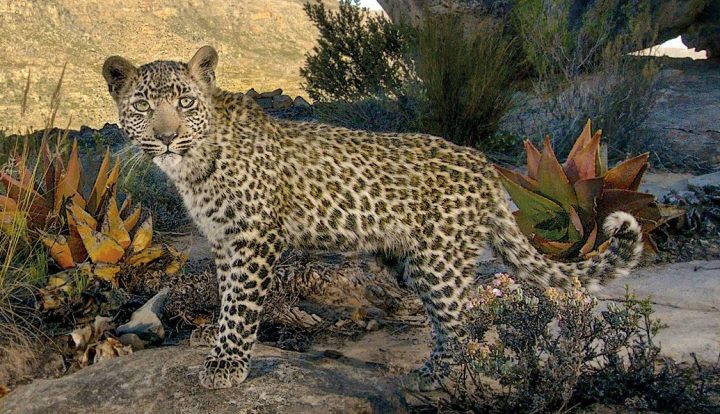
Miraculously, and despite being officially classified as ‘vermin’ or ‘damage-causing animals’ and with a bounty on their heads until as late as 1968, leopards in the Cape somehow managed to survive four centuries of intense persecution. Now, a new generation of conservationists and private landowners has improved their chances of survival into the future. This is an edited extract from ‘Against the Odds — The Remarkable Story of Leopards at the Cape’, published by the Cape Leopard Trust.
Elusive, enigmatic, mysterious, ghost-like …
Of all the creatures that still inhabit the steep peaks and deep valleys of the Cape’s rugged fynbos-clad Cape Fold Belt mountains, it is the magnificent leopard that most stirs the senses and quickens the pulse. Ironically so, perhaps, because this near-mythical creature almost never reveals itself to humans as it patrols the wild landscapes of a region that has largely survived the relentless drive of human expansion and the accompanying taming of Nature.
Leopards everywhere are solitary and stealthy by nature, although sometimes these most private of big cats surprise by openly displaying themselves for human observers — and then they invariably vanish again in the blink of an eye. Nowhere, however, is the known presence of leopards rewarded with fewer actual sightings than among the high rocky plateaus and deep, thickly vegetated kloofs of the southwestern Cape.
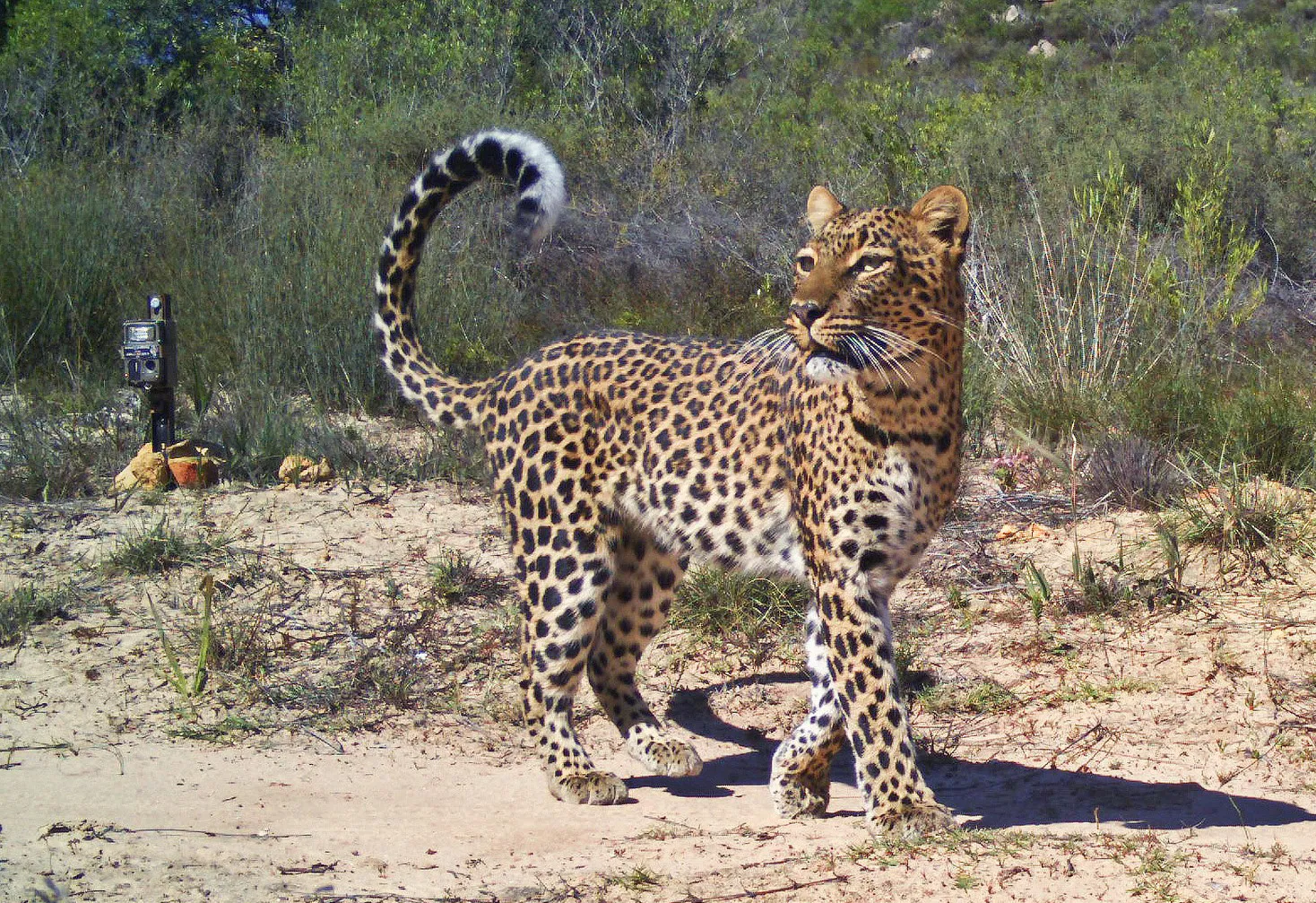
A photo of a leopard taken by a camera trap near Piketberg. The second camera visible behind the animal enables the leopard’s other flank to be recorded simultaneously. (Photo: Cape Leopard Trust)
In these rugged, inhospitable fynbos regions, the animals often popularly but scientifically inaccurately referred to as Cape leopards or Cape mountain leopards usually only confirm their occupancy through a handful of tantalising signs, smells or — less frequently — sounds. They may leave their unmistakable paw prints in the sand; deposit scat containing small bones, fur and other detritus of their prey; and gouge deep claw marks into the bark of trees like ancient Clanwilliam cedars and waboom proteas. Or it may be the raw, pungent smell of urine sprayed to demarcate territories that provides a small peephole into these animals’ otherwise seemingly impenetrable cloak of invisibility. Occasionally, very lucky hikers may hear the leopard’s tell-tale rasping cough …
Like all big cats, other predators and potentially dangerous megafauna elsewhere in Africa, the leopards of the Cape have co-existed with humans for millennia, albeit in an uneasy state of constant tension. But with the advent of European colonialism from the middle of the 17th century, both the leopard and other megafauna faced immediate and intensive persecution by the new arrivals from a different continent. And as these settlers and their domestic livestock dispersed widely into leopard habitat over the next few centuries, this persecution increased exponentially — and the impact was devastating. Soon, elephant, lion, spotted and brown hyena, buffalo and rhino as well as a number of smaller species had all been eliminated here.
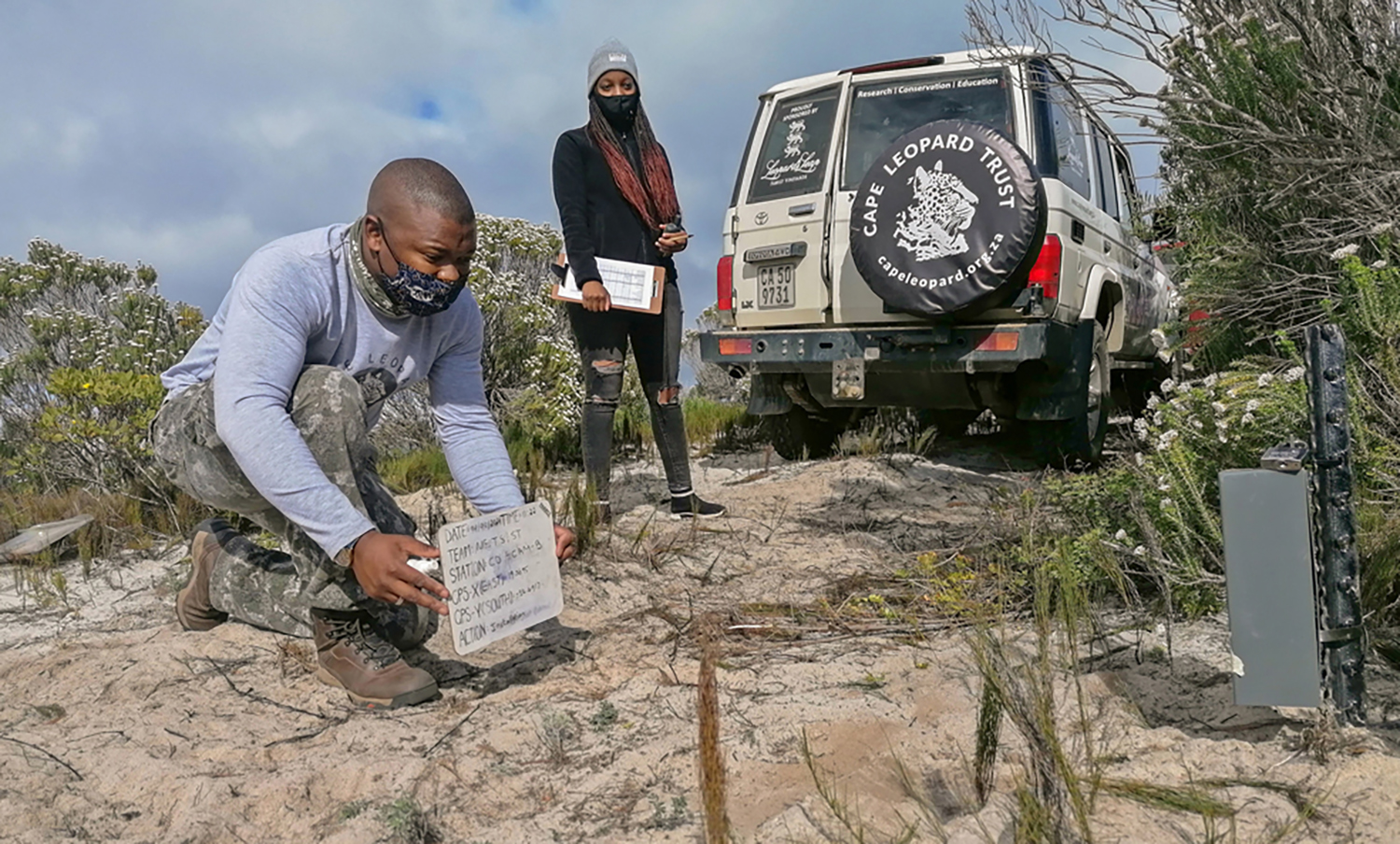
Conservation Field Officer Silindokuhle Tokota and student Michelle Shilenge setting up a camera trap in the Overberg area in 2021. (Photo: Cape Leopard Trust)
Miraculously, and despite being officially classified as ‘vermin’ or ‘damage-causing animals’ and with a bounty on their heads until as late as 1968, leopards in the Cape somehow managed to survive, courtesy of their secretive nature, largely nocturnal habits, adaptability, and unmatched ability to ‘disappear’ into the landscape. But until around the turn of the 21st century, the number of leopards killed by humans was still high, and despite their ‘threatened’ conservation status, permits to shoot individual leopards deemed ‘problem animals’ were still freely issued.
Visit Daily Maverick’s home page for more news, analysis and investigations
The majestic Cederberg area, some 200 km north of Cape Town, is a case in point. After a comprehensive audit in 1989 of the 710 sq km proclaimed Cederberg wilderness area that constituted prime habitat — and where the species was fully protected — CapeNature officials estimated that fewer than 20 leopards remained here. Nonetheless, between 1988 and 1990, 21 leopards were killed in the surrounding farming areas, based on permits issued by the conservation authority. Such losses were simply not sustainable, and local extinction seemed inevitable.
Fortunately, the last few decades of the 20th century witnessed a profound change in attitudes to the leopards of the Cape and a resulting improvement in their exceedingly tenuous hold on survival here. Thanks particularly to the efforts of passionate and committed individuals and researchers, a new generation of enlightened landowners and nature conservation officials, and the emergence of dedicated conservation groups like the Cape Leopard Trust and its associates, the once ‘problem animal’ has now become a flagship conservation icon of the Fynbos.
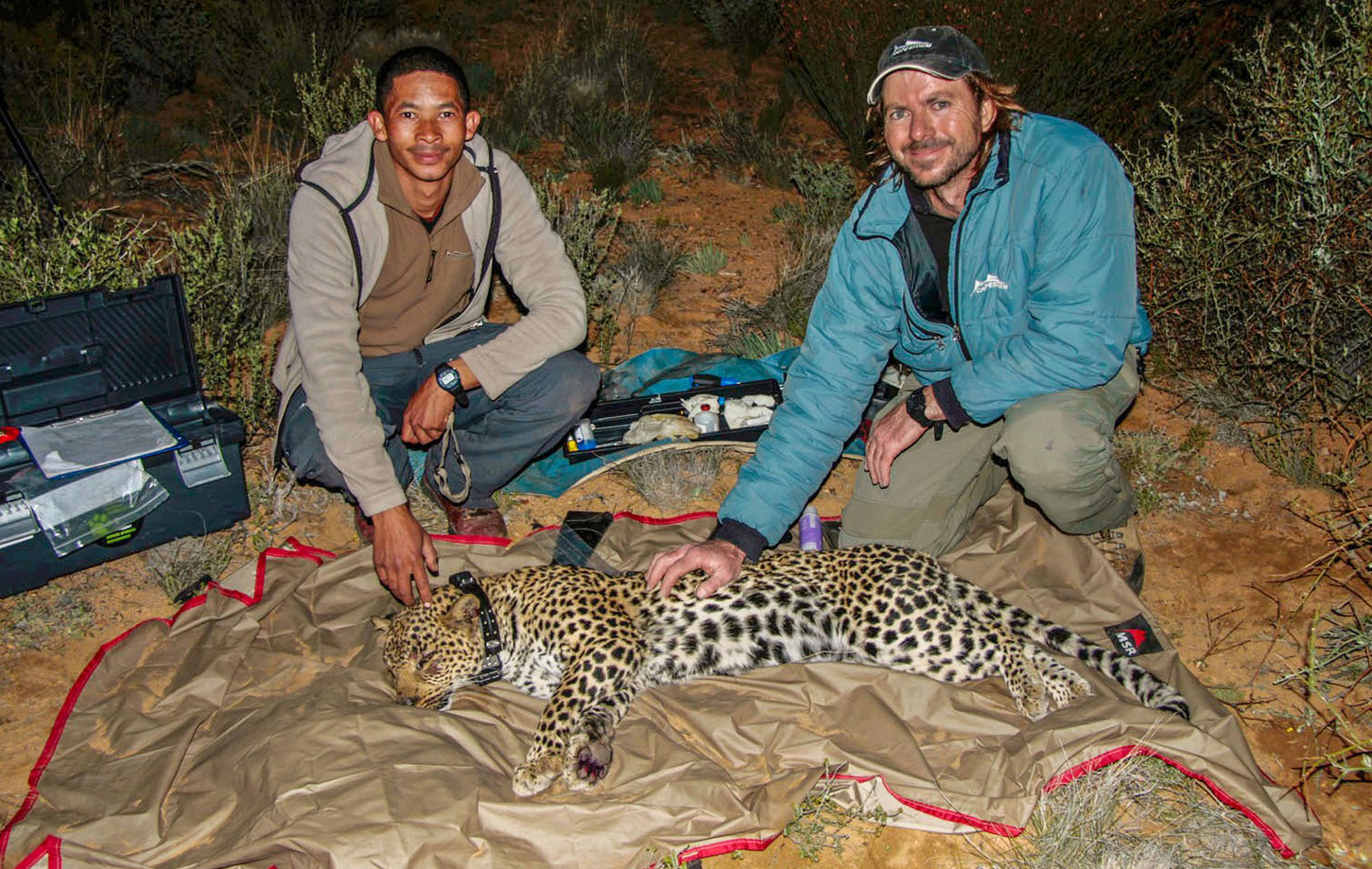
Cape Leopard Trust co-founder Quinton Martins, right, and his field assistant Willem Titus after fitting a tracking collar to an anaesthetised leopard during the early years of CLT research in the Cederberg. (Photo:Cape Leopard Trust)
A crucial telephone conversation between Quinton Martins and Johan van der Westhuizen in March 2004 lies at the heart of the founding of the Cape Leopard Trust. Despite their considerable differences in age, temperament and circumstance, this conversation sparked a deep personal relationship and synergy between the two men.
A stockbroker and financial adviser by profession, Van der Westhuizen had inherited the historic Cederberg farm Keurbosfontein that was also a founder property in the Cederberg Conservancy, and before his phone conversation with Martins remembers hearing about ‘this crazy guy’ walking around in the Cederberg looking for leopards.
Nature-loving Martins had worked as a specialist guide and camp manager in the safari industry, where he first encountered and became entranced by the species that would shape and define his future life. He observed closely and learned from local trackers who expertly interpreted the habits and behaviours of the highly secretive felines. ‘“I really had my first intimate experience working with leopards in 1993 while tracking these incredibly elusive and majestic cats on foot with highly skilled local Shangaan trackers. This is really what got me connected with leopards and that has left an indelible impression on me. Of all the cats, leopards really stood out as my favourite,’” he remembers.
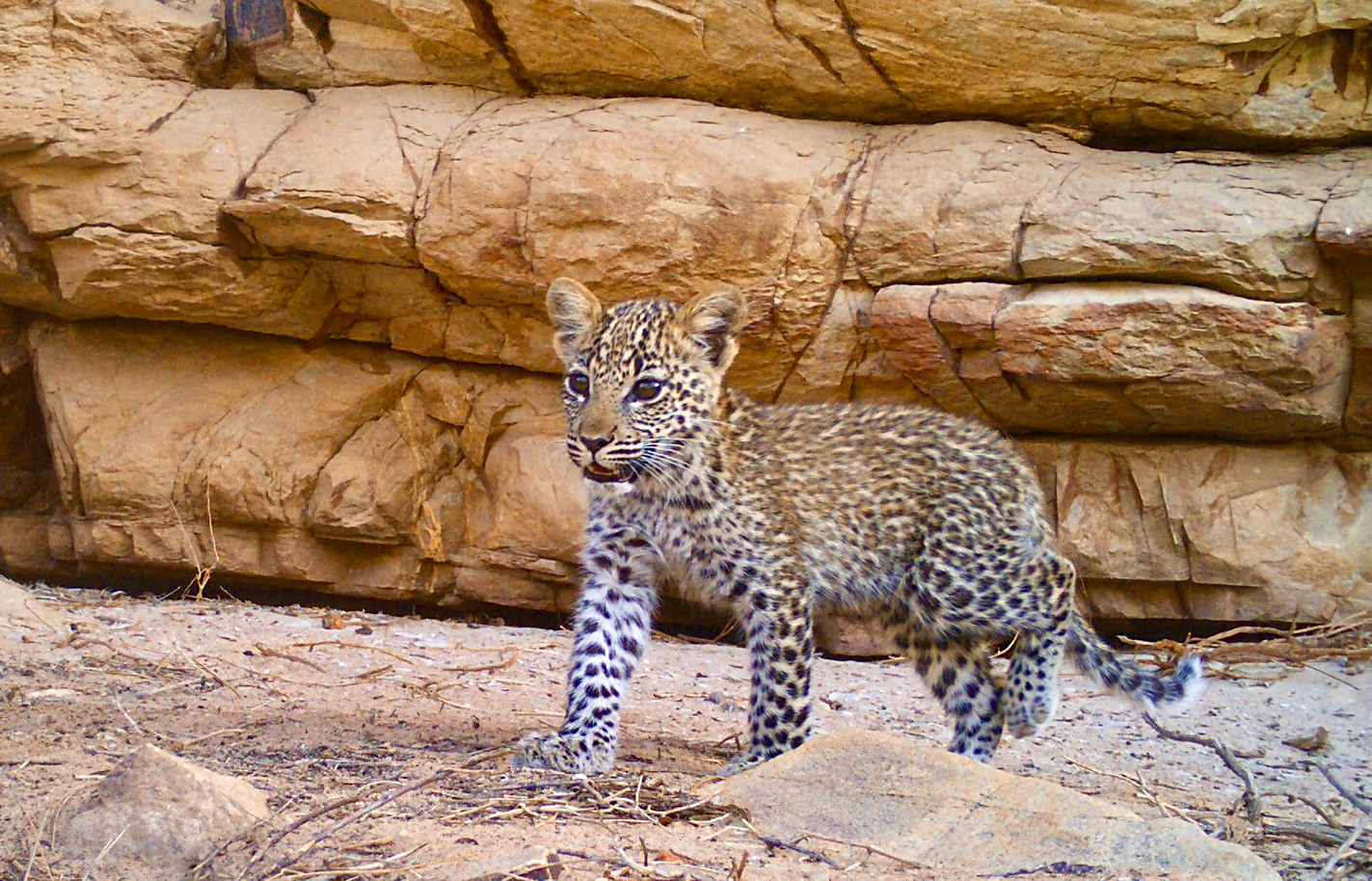
A curious leopard cub approaches a camera trap in the Cederberg Wilderness Area. (Photo: Cape Leopard Trust)
In 2000, aged 28, Martins returned to university, enrolling for a BSc degree in zoology at UCT. While studying, he visited the Cederberg, where he quickly became entranced with the wild landscape and the ethereal presence of the most elusive and mysterious inhabitants of this mountain region. With so little known about these leopards, it was an obvious choice for an exciting if highly challenging post-graduate research project …
After their initial phone call to set up a meeting, Martins visited Van der Westhuizen in his office to explain his passion for leopards and his research, and ask whether he could visit Keurbosfontein. A visionary man who shared Martins’ passion, Van der Westhuizen saw a big opportunity in the young researcher’s quest and handed Martins a cheque for R15,000 (now about R40,000) so that he could continue his fledgling project. He no longer recalls all the details of their meeting, but his one crucial response is etched in Martins’s memory: “Johan told me, ‘I really want you to carry on this work’ – and I burst into tears.” DM
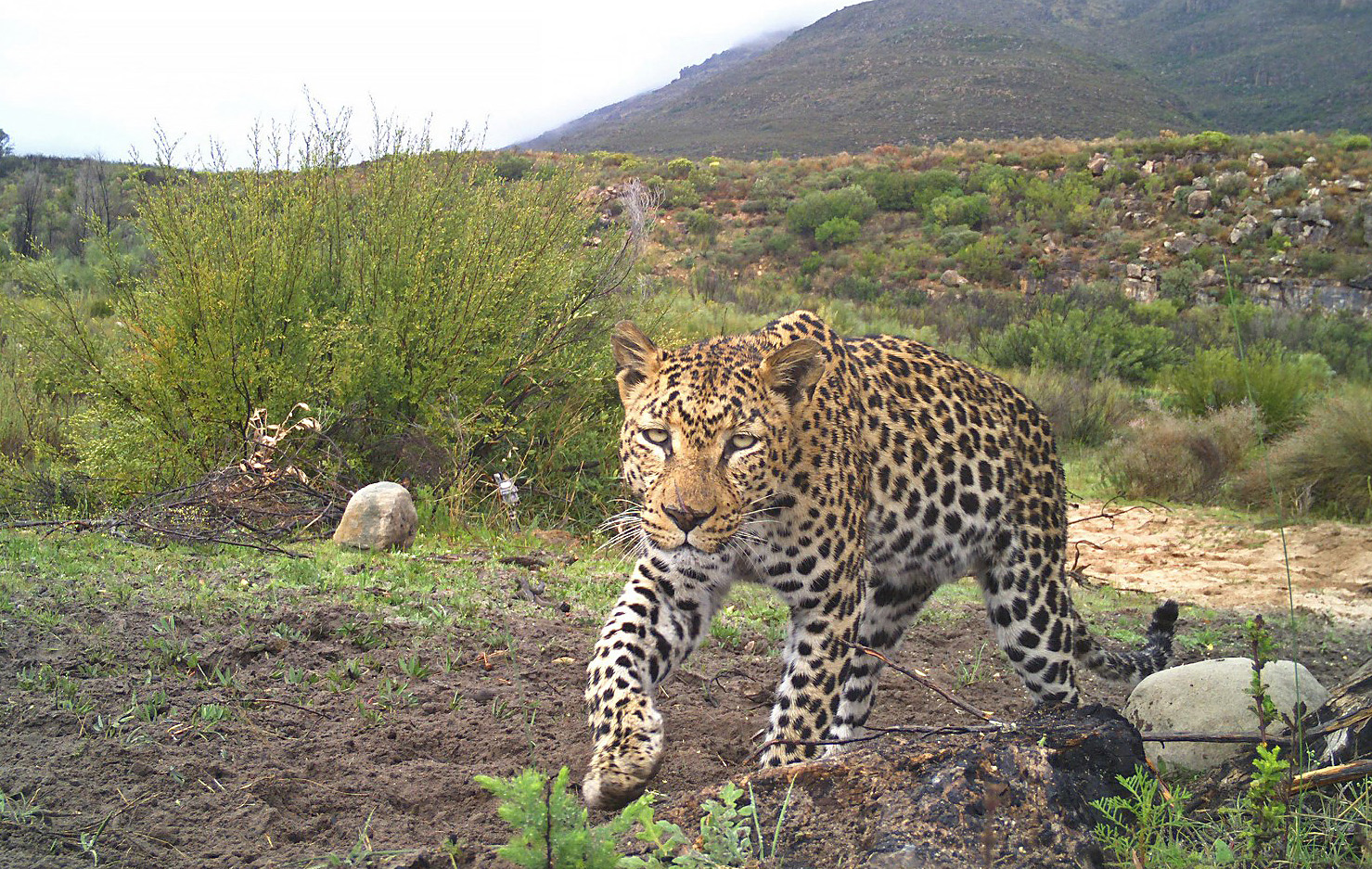
A leopard photographed by a camera trap in the Cederberg Wilderness Area in 2017. (Photo: Cape Leopard Trust)
This is an edited extract from Against the Odds, The Remarkable Story of Leopards at the Cape, published by the Cape Leopard Trust (R395).




















 Become an Insider
Become an Insider
Hopefully this means a possibility of survival for these absolutely fabulous cats 🤗
What a marvellous story – always heartening to find that there are still those that care about the natural side of this wonderful country. All the bad political and economic news fades away when you read something like this. Thank you!
Thanks John, for bringing this story to us. I’ve always loved the fact that we have free ranging leopards in our mountains. Remember the Bettys Bay saga? I once encountered hours old leopard spoor during an early morning cederberg hike and that really brought home the reality that these spotted ghosts were living in the area.
Looking forward to getting my copy.
Keep up your great work 👍🏻😊🥇
So beautiful to see photos of leopards with Cedarberg sandstone behind….. I have seen many a paw print trail pressed into the soft sands, never a glimpse of the animal itself. Thank you!
What a cool story. Long live the Cederberg. Developers must fall!